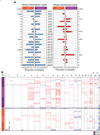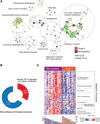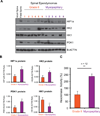Spinal Myxopapillary Ependymomas Demonstrate a Warburg Phenotype
- PMID: 25957288
- PMCID: PMC4537825
- DOI: 10.1158/1078-0432.CCR-14-2650
Spinal Myxopapillary Ependymomas Demonstrate a Warburg Phenotype
Abstract
Purpose: Myxopapillary ependymoma (MPE) is a distinct histologic variant of ependymoma arising commonly in the spinal cord. Despite an overall favorable prognosis, distant metastases, subarachnoid dissemination, and late recurrences have been reported. Currently, the only effective treatment for MPE is gross-total resection. We characterized the genomic and transcriptional landscape of spinal ependymomas in an effort to delineate the genetic basis of this disease and identify new leads for therapy.
Experimental design: Gene expression profiling was performed on 35 spinal ependymomas, and copy number profiling was done on an overlapping cohort of 46 spinal ependymomas. Functional validation experiments were performed on tumor lysates consisting of assays measuring pyruvate kinase M activity (PKM), hexokinase activity (HK), and lactate production.
Results: At a gene expression level, we demonstrate that spinal grade II and MPE are molecularly and biologically distinct. These are supported by specific copy number alterations occurring in each histologic variant. Pathway analysis revealed that MPE are characterized by increased cellular metabolism, associated with upregulation of HIF1α. These findings were validated by Western blot analysis demonstrating increased protein expression of HIF1α, HK2, PDK1, and phosphorylation of PDHE1A. Functional assays were performed on MPE lysates, which demonstrated decreased PKM activity, increased HK activity, and elevated lactate production.
Conclusions: Our findings suggest that MPE may be driven by a Warburg metabolic phenotype. The key enzymes promoting the Warburg phenotype: HK2, PKM2, and PDK are targetable by small-molecule inhibitors/activators, and should be considered for evaluation in future clinical trials for MPE.
©2015 American Association for Cancer Research.
Conflict of interest statement
The authors of this manuscript have no conflicts of interest to disclose.
Figures






References
-
- Christofk HR, Vander Heiden MG, Harris MH, Ramanathan A, Gerszten RE, Wei R, et al. The M2 splice isoform of pyruvate kinase is important for cancer metabolism and tumour growth. Nature. 2008;452:230–233. - PubMed
-
- Mridha A, Sharma M, Sarkar C, Suri V, Rishi A, Garg A, et al. Myxopapillary ependymoma of lumbosacral region with metastasis to both cerebellopontine angles: report of a rare case. Child's nervous system : ChNS : official journal of the International Society for Pediatric Neurosurgery. 2007;23:1209–1213. - PubMed
-
- Ilhan A, Furtner J, Birner P, Rössler K, Marosi C, Preusser M. Myxopapillary ependymoma with pleuropulmonary metastases and high plasma glial fibrillary acidic protein levels. Journal of clinical oncology : official journal of the American Society of Clinical Oncology. 2011;29:7. - PubMed
Publication types
MeSH terms
Substances
Grants and funding
LinkOut - more resources
Full Text Sources
Molecular Biology Databases
Miscellaneous

